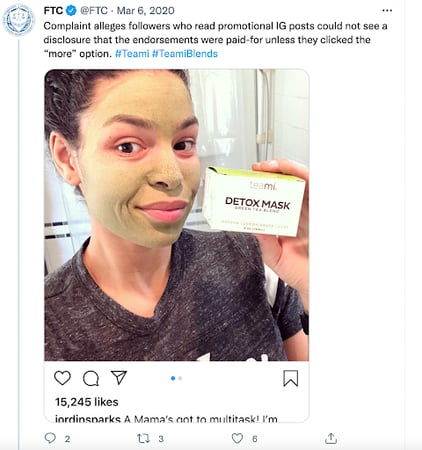Brands now rely on influencer marketing more than ever, mainly because of its success rates and likeability. Experts predict the market to grow to nearly $16.4 billion in 2022. However, like other marketing strategies, this approach comes with unique risks. Let’s review some of these vulnerabilities and ways to minimize them.
1. Prioritize Compliance
The Federal Trade Commission (FTC) has recently cracked down on content creators and brands with missing hashtags or unlabeled content. For example, the Teami brand has been under FTC fire for several years due to inadequate disclosures. And a handful of celebrities and mega influencers who endorsed Teami have received FTC complaint letters. You can see below part of the FTC chatter on Twitter.
Whether the influencer is an A-list celebrity or a micro-influencer, FTC rules still apply. As a result, brands must partner with influencers with a record of following these guidelines. That said, micro-influencers are predicted to make a big splash in 2022. Despite having traditionally smaller audiences, they’re typically more engaged and ready to take action.
With more brands partnering with less experienced influencers, the FTC will likely tighten its Endorsement Guides and disclosure guidelines. Unsurprisingly, influencer guidelines have shifted from advisory to mandatory rules that the FTC can (and will) enforce. The agency recently sent Notice of Penalties letters to more than 700 businesses nationwide. Now is undoubtedly the time to get creative; however, coloring in the lines is a brand’s best bet.
2. Define Expectations
Forming any partnership requires putting pen to paper. A written agreement serves as a guideline and establishes expectations for both parties involved. Without this contractual arrangement, legal issues can unfold quickly.
Regarding an influencer marketing contract, try to consider various angles. According to Forbes, most brands do well in writing their own contracts to protect themselves and clarify essential expectations. For example, consider including the following elements in your influencer marketing contract:
- Scope of the assignment: Define precisely how the creator will deliver the content to you and whether you must approve before publishing. Also, consider specifying the content rights and tracking strategy.
- Brand message: Although creators thrive at putting their unique twist on marketing messages, provide them with your key message to keep them on target. Aside from your core message, arm the creator with your visual guidelines.
- Compensation: Payment terms are often one of the most important aspects of a successful professional relationship. As you prepare to negotiate terms, there are many considerations to make. Remember to include the how and when.
- FTC compliance: Learn how to disclose your partnerships with influencers to build brand trust with customers and outline your expectations for the creator regarding FTC compliance.
3. Use Your ROMI as a Guide
Carefully planned influencer marketing strategies usually enjoy a higher return on investment than a haphazard approach. After all, creators tend to have an unrivaled storytelling talent, engaging audiences and boosting conversation rates. But brands need quantifiable results from their marketing efforts, making the return on marketing investment (ROMI) a top priority.
Keeping your accountant happy typically means saying, “we spend X amount to earn Y.” Fortunately, with social media and Google analytics, brands can track their efforts more precisely. Unsurprisingly, influencer marketing is often comparable to or does better than other channels. This tactic is undoubtedly one of the more nuanced marketing strategies.
For example, although brands ultimately want to win sales, other factors besides conversions are also meaningful. Engagement, comments, reach, and impressions are vital in achieving your conversion goals. Roughly 90% of marketers use engagement and less than 50% use conversation rates to measure their ROMI. Regardless of how you measure your ROMI, an excellent approach is to use this data to guide you in your marketing efforts.
4. Understand Legal Liability
Litigation in the US has steadily increased over the past few decades. The headlines clue us into various influencer lawsuits, from FTC violations to contract breaches. It’s safe to say that brands that understand their legal responsibilities tend to enjoy more success and longevity than those that don’t. While influencer marketing is often lucrative for brands and creators, both parties must understand what comes with the territory.
For example, the case of Petunia Products, Inc. v. Rodan & Fields, LLC and Molly Sims displays how influencers and brands can become looped into litigation. The actress Molly Sims discussed and recommended a “Brow Defining Boost” product in a sponsored blog post. However, Petunia Products Inc. claimed that the post infringed on its “Brow Boost” mark.
Although Petunia naming Sims in this trademark infringement case seems highly irregular, we’ll likely see an uptick in similar litigation. Brands typically focus on competitors infringing products, not influencers. But this might potentially become a new legal strategy for plaintiffs.
Brands must be aware of their ecosystem’s vulnerability. In other words, consider what exposures your partner influencer might face, given the sideways legal strategies surfacing nowadays. Remember that the Sims case could have fallen flat from the start, but the court pursued the direct infringement claim. No matter the outcome, this situation has caused massive pressure on Sims and her partner brand, Rodan & Fields, LLC.
5. Backup Your Product
Regardless of what brands try to sell, it’s vital to establish a safety net for when or if something regarding a product or service goes wrong. Consider working with a seasoned commercial insurance broker to identify unique industry risks and create tailored plans that meet your brand’s needs. In the meantime, here are a handful of recommended coverages:
- General liability protects brands against basic business risks and serves as the foundation of any risk management plan.
- Business interruption insurance replaces income lost and extra expenses.
- Cyber liability protects brands against damages from specific electronic activities.
- Property insurance reimburses companies for direct property losses.
- Product liability protects against claims alleging your product or service caused injury or damage.
- Media liability protects creators and brands from potential lawsuits involving their social media activities.
- Professional liability protects brands against lawsuits of inferior work or service.
Influencer marketing is shaping multiple platforms and industries, so it only makes sense to consider this lucrative strategy. However, you don’t have to dive in aimlessly. Following the five tips above will help you de-risk your influencer marketing strategy and support your brand for the long haul.
Check out Founder Shield for more information about influencer insurance.
-1.png?width=239&name=Julius%20By%20Triller%20-%20Wordmark%20-%20Purple%20(1)-1.png)







